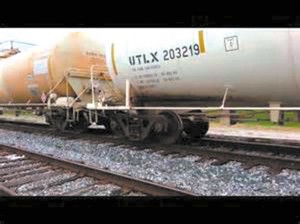EPA is expected to tighten its ozone rule
1st June 2015 · 0 Comments
By Susan Buchanan
Contributing Writer
The U.S. Environmental Protection Agency has signaled that it will announce a stricter ground-level ozone standard this fall. Ozone or O3–made of three, joined oxygen atoms—is created when sunlight hits gases emitted by industrial facilities, power plants, road vehicles, locomotives and ships. It differs from O2, the two joined oxygen atoms that we breathe. Ground-level or “bad” ozone from land to 10 miles up in the air is harmful to human health. But 10 to 30 miles above land, ozone acts as a protective shield from the sun’s rays.
Elevated ground-level ozone is a particular worry for those with respiratory ailments, children and the elderly. Repeated exposure to excessive ozone can scar lung tissue. South Louisiana and other warm, sunny places tend to be high in ground-level ozone, especially on summer afternoons when asthma attacks are common. Ground-level ozone also corrodes building materials, statutes and rock formations.
The EPA will make a decision about its ozone standard by October 1, Jennah Durant, EPA spokeswoman in Dallas, said last week. “On November 25, EPA proposed revising the standard to a level between .065 and .070 parts per million,” she said. The current standard, set in 2008, is .075 parts per million.
All of Louisiana’s 64 parishes are in compliance now with the current standard, according to Vivian Aucoin, senior scientist with the state’s Department of Environmental Quality air permits division. “The only area designated as in non-attainment or noncompliance by EPA is the five-parish Baton Rouge Area—Ascension, East Baton Rouge, Iberville, Livingston and West Baton Rouge,” she said last week. “But that area achieved the standard on Dec. 31, 2013, well ahead of a 2015 deadline. Although the Baton Rouge area hasn’t been re-designated by EPA yet, our monitors show it meeting the standard.”
The capitol area will be acknowledged as in compliance soon. “We expect to make a finding later this year that Baton Rouge met its attainment date,” Durant said.“Re-designating the area is a long process requiring that LDEQ submit a request with supporting paperwork. LDEQ is working on that request.”
The five-parish Baton Rouge area along the Mississippi River hosts big industrial employers, including ExxonMobil, Exxon Chemicals America, BASF, Shell Chemical, Dow Chemical and Georgia-Pacific.
“Control measures on volatile organic compounds and oxides of nitrogen were in place in the Baton Rouge area in 2013,” Aucoin said. “Flares burn more efficiently there now, reducing air pollution.” Controls on internal-combustion sources, along with operations that use waste gases, instead of emitting them into the air, are other measures adopted by that area’s plants.
“In Baton Rouge and New Orleans, air quality generally has been improving, with the most recent, three-year averages putting ozone in Baton Rouge at .072 parts per million and New Orleans at .071 parts per million,” EPA’s Durant said.
Entergy Corp. has slashed its carbon dioxide or CO2, sulfur dioxide or SO2, and nitrogen oxide or NOx emissions since 2000, while generating more power, company spokesman Michael Burns in New Orleans said last week. “NOx is a key precursor of both ground-level ozone and smog,” he said. Most of the power generated by Entergy now is from non-emitting nuclear and low-emitting, natural-gas fired Combined Cycle Gas Turbines or CCGT.
“Electricity generation with nuclear energy at the Waterford 3 plant in St. Charles Parish prevents the emission of SO2, NOx and greenhouse gases like CO2–associated with burning fossil fuels,” Burns said. Entergy’s newly built Ninemile Point Unit 6 in Westwego, which started up in December, uses combined-cycle technology and requires 30 percent less fuel than older, natural gas-fired units.” That helps us keep emissions low,” he said. Entergy hopes to build another CCGT facility in St. Charles Parish next to its Little Gypsy generating units, and is waiting for internal and regulatory approvals.
Hybrid work trucks and cars have been added to Entergy’s southeast Louisiana fleet, and the company plans to acquire more of them, Burns said. Entergy’s fleet includes gasoline/electric hybrid vehicles; diesel/electric/JEMS or Jobsite Energy Management System vehicles—which can be plugged in at night to charge batteries; and compressed natural gas vehicles.
In a “path forward” letter to EPA in February 2014 about reducing ozone, the Regional Planning Commission in New Orleans credited fleets run by the Regional Transit Authority, Jefferson Transit, New Orleans Public Belt Railroad, CSX Transportation, Entergy, Progressive Waste Solutions and others as having moved to cleaner fuels and technologies.
Until recently, locomotives spewed particulate matter and NOx in great quantities. Florida-based CSX Transportation last week said use of idle reducing technologies or IRTs has helped cut emissions and thus ozone in greater New Orleans. In the city, the company operates a rail yard in Gentilly, along with an intermodal terminal and a transloading terminal for bulk commodities.
“Since 2000, CSX has invested in two IRTs, with one called Auxiliary Power Units or APUs, and the other Automated Engine Start Stop or AESS,” CSX spokeswoman Kristin Seay said. APUs lower a locomotive’s idling by providing auxiliary power during shutdowns. AESS automatically shuts a locomotive that’s not in use, and starts it when needed. In the last decade, CSX locomotives were updated in other ways too. “Overall, CSX has improved its fuel efficiency by 100 percent since 1980,” Seay said. “Today, a CSX train can move a ton of freight more than 480 miles on one gallon of fuel.”
What can south Louisiana expect if EPA announces a stricter ozone standard this fall? “States will have a few years to submit their clean air plans, called state implementation plans, or SIPs, to EPA,” Durant said. These plans will explain how states intend to bring any “non-attainment” areas into compliance.
Meanwhile, on the natural side, winds from the Gulf of Mexico help dissipate south Louisiana’s ground-level ozone.
This article originally published in the June 1, 2015 print edition of The Louisiana Weekly newspaper.




